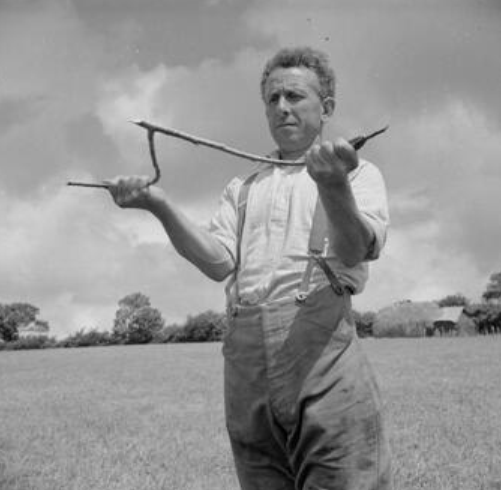
I have a fascination with water witching because I think it proves some of my more mystical theories to doubters. The thing with this ‘science’ is that it works, even if no one knows, or maybe wants to say, why. If it didn’t work, people in the old days out in West Texas wouldn’t have paid witchers to find a water source, right? It wouldn’t take long to discover a fraud. You either find water or you don’t.
I saw a news story about how some companies still use witching to find buried water pipes. The way it works is you get a forked stick (people have different opinions here on what kind, or if one should use metal etc.) anyway you get a stick with a fork in it, and you hold it out in front of you at a certain angle. When you cross over water, the stick will jerk and point downwards, and there you dig. Some people are better at it than others. It takes practice, they say, and you have to have “the gift”. There was a time when Bangs ran out of water, and the witchers were called in to find some.
According to a former postmaster in Bangs, Ben Sullivan, who wrote a short history of the town called Bangs, Texas – Early History, in 1886 and 1887 Bangs was suffering through a severe drought. Sullivan says, “In the year 1886 the first gin was built in Bangs by S. P. Martin and T. J. Backus. During the years of 1886 and 1887 water was very scarce, and they paid thirty-five cents per barrel to have water hauled from Thrifty with which to operate the gin. Also with the coming of the railroad, trains would deliver water in barrels for town use, leaving them at the depot. However, it was reported that stray cattle would turn all the water over on occasion, leaving the town without water until the next train came through.” This was, as you can imagine, a true crisis that threatened to obliterate Bangs. No water, no town at all.
“Soon thereafter, however, it was discovered that upon the exact spot where the gin was located water was quite plentiful at a depth of only ten feet.The first gin was located some 500 yards east to northeast of the present location of the First State Bank,” Sullivan continues. “With the location of the first shallow well, people of the area began digging their own wells and found that the Bangs area was sitting on top of an abundant water supply. Water witching became quite a lucrative business. Some of the water witchers were remarkably accurate in their estimation of where water could be found. Famous for his ability as a water witch was a man by the name of Jacob Tervooren, who was reported to have an almost uncanny aptitude for discovering water and being able to judge the exact depth at which it could be found.”
It’s truly amazing if you think about it that you can find water with a stick. I recently read an article, and I can’t remember where, about how you can also use the practice to find graves and even to discern the sex of the person buried in the grave. I believe this, maybe it has to do with electromagnetic forces, although I’m not going to try and prove that. I keep wanting to try it, but then wonder how I could explain to the neighbors what I’m doing. Believe in it or not, it’s a good thing they tried it over in Bangs. It’s odd to think that without the water witchers, Bangs might not have survived at all.
***
Diane Adams is a local journalist whose columns appear Thursdays on BrownwoodNews.com
